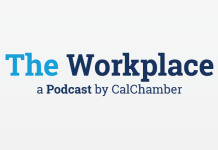In this episode of The Workplace podcast, CalChamber Associate General Counsel Matthew Roberts and Senior Employment Law Counsel Erika Barbara discuss litigation trends and what steps employers can take to avoid or defend against claims.
Litigation Trends
Barbara says that over the last several years, there has been a steady increase in wage-and-hour, class and Private Attorneys General Act (PAGA) actions. These cases usually are brought by a current or former employee who’s seeking to represent themselves and all other employees who have worked for an employer in a certain period of time. They’ll seek damages, as well as penalties like waiting time penalties, wage statement penalties, and PAGA penalties.
“What we started to see was these types of cases had become a kind of cottage industry for a growing number of plaintiff-side law firms,” Barbara says. “There were firms that were literally filing hundreds of class and PAGA actions every year. And many of the firms were filing cookie cutter complaints that alleged the same laundry list of claims in every case, really just changing the name of the plaintiff in each case, and sometimes even forgetting to do that.”
In addition to these types of claims, Barbara says, wage-and-hour claims were tacked on to single plaintiff cases.
What Is PAGA?
The Private Attorneys General Act is a law that allows an individual, who is referred to as an “aggrieved employee,” to step into the shoes of the state, and sue an employer on behalf of other aggrieved employees for various Labor Code violations, and in doing so recover penalties on behalf of the state. Any penalties recovered in a PAGA case are distributed or paid out — 75% to the state and 25% to the group of aggrieved employees, Barbara says.
So why are PAGA cases attractive to plaintiff’s attorneys?
One, the law provides for the recovery of attorney’s fees when a plaintiff or an aggrieved employee prevails at trial, or if the case settles. For example, if there is a settlement of a million dollars, 30% to 40% of that goes to the plaintiff’s attorney for their fees right off the top. What remains gets paid out as penalties, with 75% going to the state and 25% going to all of the employees.
This incentivizes the attorneys who filed these claims, because they can recover a sizable percentage of the settlement for their attorneys’ fees, Barbara says. PAGA claims are also appealing because the attorneys filing these cases will seek penalties for numerous alleged violations of the Labor Code, and then argue that those penalties should be stacked on top of each other, which will then drive up the value of the case significantly.
Audit to Ensure Compliance
Now more than ever, compliance with wage-and-hour requirements is critical, Barbara stresses.
A common claim in class PAGA actions and one that can be easy to allege is failure to provide accurate itemized wage statements. California has very specific requirements for what information must be included in a wage statement. If any of the required information is missing, the wage statement is not compliant. The Labor Code imposes penalties of up to $4,000 per employee for failure to provide compliant wage statements. And these are penalties that can add up really quickly, Barbara says.
“As crazy as this may sound, cases have been filed because of what can be only minor errors with, for instance, the name of the employer on the wage statement. So, you could have the employer’s name not being the actual correct legal name of the employing entity, and that’s a violation,” she tells Roberts.
Employers should audit their wage-and-hour policies and practices to ensure compliance, Barbara stresses. This means reviewing the employee handbook to confirm it contains all relevant policies, ensure its compliance, and check that everything is up-to-date.
But compliant policies are only part of the equation—they don’t mean anything if they aren’t followed, Barbara points out.
Employers should review the actual practices in the workplace. Is the meal-and-rest period policy being followed, or are employees being allowed to disregard it and take breaks as they please?
Audits can also reveal additional practices that an employer may want to implement. For example, many California employers have begun using attestations or acknowledgments in their timekeeping systems, so that employees confirm either at the end of every day, week or pay period that the time they’ve entered is correct, and that they’ve been provided the opportunity to take all meal and rest breaks.


